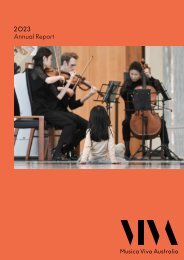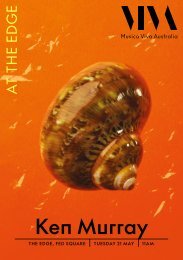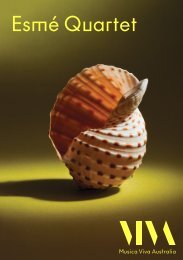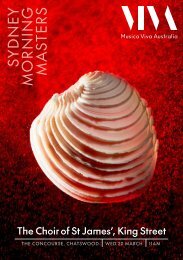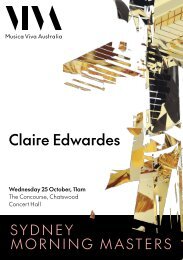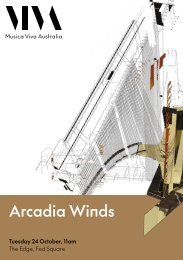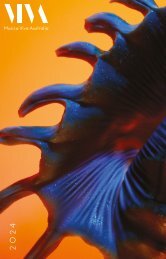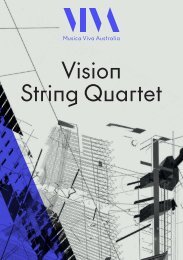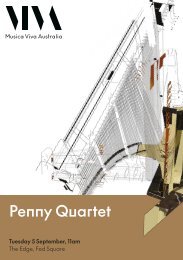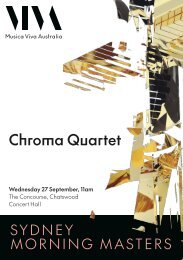Australian String Quartet & Konstantin Shamray Program Guide | March 2022
You also want an ePaper? Increase the reach of your titles
YUMPU automatically turns print PDFs into web optimized ePapers that Google loves.
ABOUT THE MUSIC<br />
|<br />
6<br />
|<br />
After the crisis provoked by the official<br />
denunciation of his opera Lady Macbeth of<br />
the Mtsensk District in 1936, Shostakovich<br />
turned his attention towards chamber<br />
music as a relatively safe vehicle for his<br />
musical thought. In 1938 he composed<br />
the first of his 15 string quartets, and in<br />
1940 premiered his one and only quintet<br />
for piano and strings. The following year, it<br />
was awarded a Stalin Prize: a sure sign of<br />
Shostakovich’s return to official favour, at<br />
least for the time being.<br />
The Quintet is one of Shostakovich’s<br />
most ‘classical’ works: which is not to say<br />
that it is without passionate expression,<br />
but that (as far as we can judge such<br />
obviously subjective matters) it lacks<br />
the autobiographical references and the<br />
touches of irony which can be identified in<br />
many of his other pieces. There is, too, a<br />
classical clarity about the textures which<br />
the composer achieves. The piano and<br />
the string quartet are treated as separate<br />
entities: the piano, for example, starts<br />
the whole work unaccompanied, as if<br />
the strings were not there, making their<br />
first entry a telling moment: and later the<br />
strings lead off the Fugue movement on<br />
their own, highlighting the piano’s longdelayed<br />
entry. When the piano and the<br />
strings do play together, it is without<br />
doubling: if the strings are in full four-part<br />
harmony or counterpoint, the piano usually<br />
adds only one line (sometimes in octaves);<br />
or if the piano has fuller harmony, the<br />
strings are usually in octaves, or reduced<br />
to one or two instruments. The piano<br />
writing itself is kept unusually clear by the<br />
same concentration on extreme high and<br />
low registers that marks Shostakovich’s<br />
orchestral writing. The use of the whole<br />
ensemble in full harmony with the middle<br />
register filled in, is reserved for a single<br />
passage, the climax of the Intermezzo.<br />
The five-movement layout of the work is<br />
an uncommonly original and satisfying<br />
one. It owes nothing to the arch forms<br />
employed by Bartók in the 1920s and<br />
‘30s; instead, it is based on a plan of two<br />
linked pairs of movements surrounding a<br />
central, pivotal Scherzo. The first paired<br />
movements, both in G minor, make up a<br />
prelude and fugue. The Prelude relaxes its<br />
initial intensity in a lightly scored middle<br />
section, and then redoubles it at the end<br />
of the movement. The Fugue, by contrast,<br />
is intense and concentrated throughout.<br />
After these two slow movements, an<br />
effective contrast is provided by the brittle<br />
high spirits and bright B major tonality of<br />
the rondo-form Scherzo. The last paired<br />
movements are an Intermezzo in D minor<br />
and a G major Finale. The Intermezzo<br />
is an outpouring of sustained melodic<br />
writing. The Finale is an engagingly relaxed<br />
affair, based on a couple of catchy but<br />
never quite predictable tunes; though a<br />
note of greater seriousness is struck at<br />
the end of the development section, in<br />
a string passage which quotes a figure<br />
from the climax of the Fugue. One of the<br />
most attractive features of this extremely<br />
attractive movement is its manner of<br />
arrival and departure: sidling in in a<br />
gradual accelerando at the beginning;<br />
disappearing into thin air at the end.<br />
ADAPTED FROM A NOTE<br />
© ANTHONY BURTON




